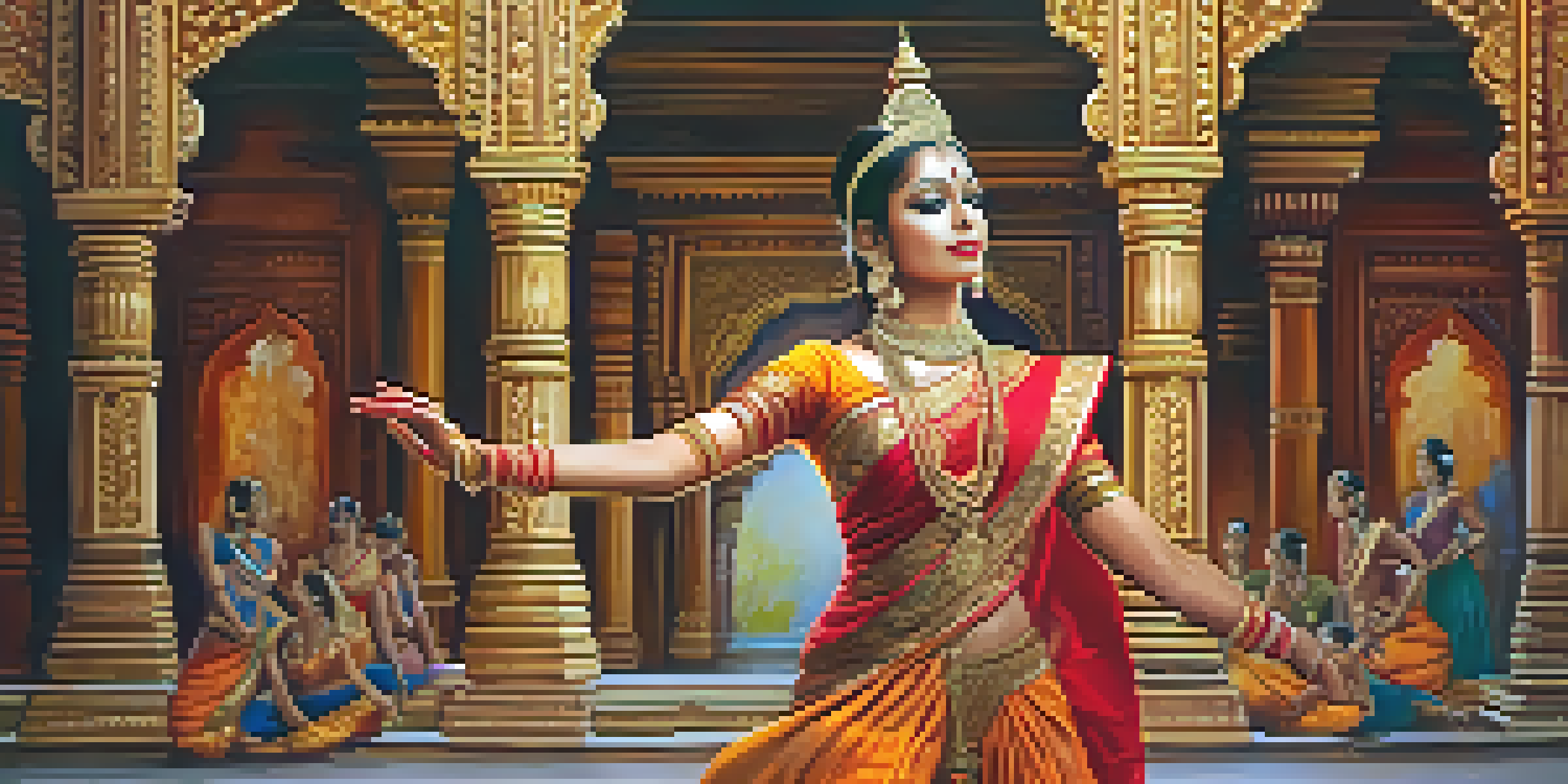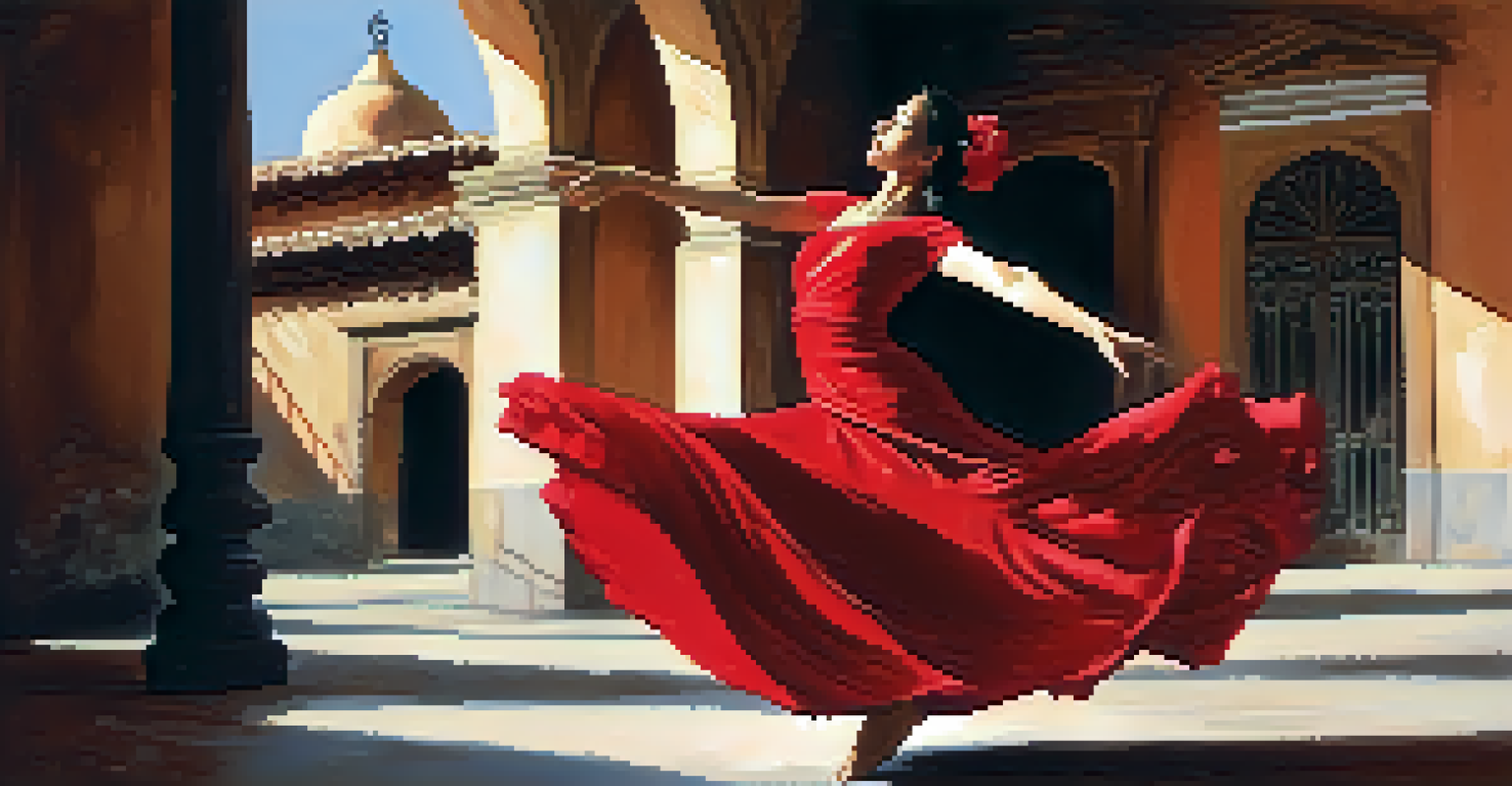Cultural Identity and Dance: A Global Perspective

Understanding Cultural Identity in Dance
Cultural identity is the sense of belonging to a particular group, shaped by various elements like language, traditions, and, notably, dance. Dance serves as a powerful form of expression, allowing individuals to communicate their cultural heritage and personal experiences. Through the rhythms, movements, and styles unique to each culture, dance encapsulates shared histories and values.
Dance is the hidden language of the soul.
For instance, consider how traditional Indian dance forms, like Bharatanatyam, tell stories of mythology and spirituality. These performances are not just entertainment; they are a way for practitioners to connect with their roots and celebrate their identity. Similarly, the vibrant movements of African dance often reflect community life, rituals, and celebrations, reinforcing social bonds.
Thus, dance becomes a living archive of cultural identity, transmitting traditions from one generation to the next. It highlights the diversity of human expression while emphasizing the common threads that bind us as global citizens. In this way, dance fosters a deeper understanding of cultural identities worldwide.
Dance as a Reflection of Cultural History
Throughout history, dance has played an essential role in documenting cultural narratives and historical events. For example, the Flamenco dance of Spain emerged from a blend of influences, including Gypsy, Moorish, and Andalusian cultures, each contributing unique elements. This rich tapestry of history is expressed through the passionate movements and emotive music of Flamenco.

In another instance, the Native American Powwow dances are not just performances; they are a celebration of heritage and resilience. These dances often commemorate historical events and honor ancestors, allowing participants to embody their history through movement. Each step in these dances carries the weight of stories passed down through generations.
Dance Reflects Cultural Identity
Dance serves as a powerful expression of cultural identity, allowing individuals to communicate their heritage and shared experiences through unique rhythms and movements.
By exploring these historical contexts, we see how dance serves as a living testament to cultural evolution. It captures moments in time, offering insights into societal changes and the enduring spirit of communities. This interplay between dance and history enriches our understanding of cultural identity.
The Role of Dance in Community and Belonging
Dance often acts as a social glue, bringing communities together and fostering a sense of belonging. In many cultures, communal dances are a staple during festivals and celebrations, where people unite to share joy and express collective identity. This bonding experience is vital for reinforcing relationships within the community.
Dancing is creating a sculpture that is visible only for a moment.
Take, for instance, the Hula dance of Hawaii, which is more than just a performance; it embodies the spirit of Aloha and the connection to nature. When people gather to participate in Hula, they share not only their moves but also their stories and values, deepening their sense of belonging. This practice highlights the importance of dance in creating shared experiences that strengthen community ties.
As such, dance becomes a vital mechanism for cultural continuity, allowing communities to celebrate their identities collectively. It offers a space for individuals to express themselves while being anchored in their cultural roots. In this way, dance nurtures community bonds and reinforces cultural identity.
Globalization and the Evolution of Dance Forms
In our interconnected world, globalization has significantly impacted dance, leading to the blending of styles and cultures. While this fusion can enrich cultural expressions, it also raises questions about authenticity and cultural appropriation. For example, the popularity of hip-hop dance has transcended its origins, creating a global movement that blends various cultural influences.
However, as dance evolves, it is essential to recognize and honor its roots. For instance, many hip-hop dancers pay homage to the African American communities that birthed the genre, ensuring that its historical significance is not lost. This awareness fosters respect for cultural origins while allowing for creative innovation.
Community Bonds Through Dance
Dance acts as a social glue, bringing communities together during celebrations and reinforcing a sense of belonging and collective identity.
Ultimately, globalization presents both opportunities and challenges for dance as a means of cultural identity. It encourages collaboration and exchange, yet emphasizes the need for sensitivity to cultural heritage. Striking this balance is crucial for the future of dance as a reflection of our diverse identities.
Dance as a Medium for Social Change
Dance has long been a powerful tool for social change, enabling individuals and communities to voice their struggles and aspirations. Many choreographers and dancers use their art to raise awareness about social issues, bridging the gap between entertainment and activism. For example, the dances of the Black Lives Matter movement encapsulate the urgency and passion behind the fight for racial equality.
In addition, contemporary dance often explores themes such as gender identity, mental health, and environmental concerns. Dancers like Pina Bausch have used their performances to challenge societal norms and provoke thought, making dance a conduit for dialogue and reflection. This transformative power of dance engages audiences and encourages them to consider their roles in societal issues.
Through these movements, dance becomes a platform for marginalized voices, amplifying their stories and experiences. It empowers individuals to express themselves and inspires others to take action. This intersection of dance and social change highlights the profound impact of cultural identity in shaping our world.
The Influence of Technology on Dance Culture
Technology has dramatically transformed dance culture, reshaping how we learn, perform, and share dance. With the rise of social media platforms like TikTok and Instagram, dance challenges and trends can go viral overnight, making dance more accessible to a global audience. This democratization of dance allows individuals from various backgrounds to showcase their skills and creativity.
Moreover, technology has expanded opportunities for collaboration and learning. Online tutorials and virtual dance classes enable people to explore different styles from the comfort of their homes. This accessibility fosters a greater appreciation for diverse dance forms, encouraging cultural exchange and innovation.
Globalization Shapes Dance Evolution
While globalization enriches dance through cultural blending, it also raises important questions about authenticity and the preservation of traditional forms.
However, this shift also raises questions about the preservation of traditional dance forms amidst the fast-paced world of digital trends. Balancing the allure of modernity with the need to honor cultural heritage is crucial for the sustainability of dance as a reflection of identity. As technology continues to evolve, it will undoubtedly shape the future of dance culture in fascinating ways.
The Future of Dance and Cultural Identity
As we look ahead, the future of dance promises to be an exciting blend of tradition and innovation. With increasing global interconnectedness, we can anticipate more cross-cultural collaborations that enrich the dance landscape. This evolution will likely lead to new forms of expression that reflect the complexities of modern identities.
Importantly, maintaining a dialogue about cultural preservation will be vital. As dancing communities navigate the influences of globalization, ensuring that traditional practices are honored will foster appreciation for cultural heritage. This balance will help sustain the essence of cultural identity while embracing new interpretations.

Ultimately, the future of dance will continue to be a vibrant tapestry of voices and experiences. By celebrating both heritage and innovation, dance will remain a powerful medium for expressing cultural identity, connecting people across the globe, and inspiring future generations.